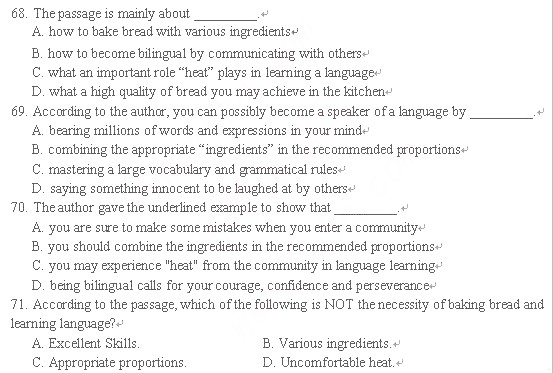As I was thinking about language learning the other day, the image of baking bread came into my mind. I compared some of the exercises and drills that we put ourselves through in order to learn a language to the various ingredients (原料) that go into baking a loaf of fresh bread.
Real language learning takes place in human relationships. No one sits down and eats a cup of flour, even if he is hungry and in a hurry. You don' t become bilingual (双语的) by learning lists of vocabulary. You don' t become a speaker of a language by memorizing grammatical rules. You become bilingual by entering a community that uses that other language as its basic means of communication.
I am not suggesting that we can make bread without ingredients. Flour is necessary, as are yeast (酵母), salt, water and other ingredients. Vocabulary is part of any language and will have to be learned. Grammatical rules exist in every language and cannot be ignored. But merely combining the appropriate ingredients in the recommended proportions does not result in bread. At best, you only end up with a ball of dough (面团).
In order to get bread, you have to apply heat to the dough. And in language learning, that heat comes from the community. Anyone who has learned a second language has experienced that heat. It creeps up your neck when you ask the babysitter, “Have you already been eaten?” when you meant to say, ‘‘Have you already eaten?” When you try to say something quite innocent and the whole room bursts into laughter, you are experiencing the heat that turns raw dough into good bread.
Remember the old saying, “If you can’ t stand the heat, get out of the kitchen". This is where language learning often breaks down because we find the heat uncomfortable and we stop the baking process. In other words, we can' t stand the heat, so we get out of the kitchen.
However, the language learner who stays in the kitchen—in the heat—until the combined
ingredients are thoroughly transformed will enjoy the richness of a quality loaf of bread. He is glad that he did not "get out of the kitchen” at the important moment when the oven seemed too hot.
Now the baker enjoys good bread, seated at the table with family members and guests. However, he does not focus on "bread" but rather on enjoying the whole feast: fine salads, pastas, fresh vegetables, rich desserts and so on. And the language learner has arrived when he no longer needs to focus on language. Language merely becomes one element in the "feast" of membership in his chosen community.
